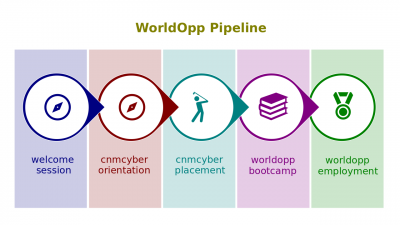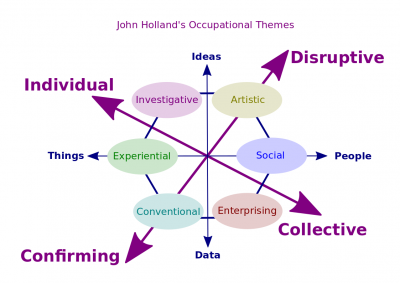Difference between revisions of "Personalities and Work"
(→Script) |
(→Script) |
||
| Line 27: | Line 27: | ||
:Although a few [[employer]]s collect [[Myers-Briggs Type Indicator|MBTI]] data, this test has little-to-no effect in the workspace. A successful sport team, for instance, should be a mosaic of ''personalities'' regardless of the fact that all of them would share the same ''occupation''. | :Although a few [[employer]]s collect [[Myers-Briggs Type Indicator|MBTI]] data, this test has little-to-no effect in the workspace. A successful sport team, for instance, should be a mosaic of ''personalities'' regardless of the fact that all of them would share the same ''occupation''. | ||
| − | :At the same time, the model of American psychologist John Holland gained some popularity among [[career counselor]]s. John Holland matched two [[personality dimension]]s, disruptive versus conforming and individual versus collective, with six groups of ''occupations''. | + | :At the same time, the model of American psychologist John Holland gained some popularity among [[career counselor]]s. John Holland matched two [[personality dimension]]s, disruptive versus conforming and individual versus collective, with six groups of ''occupations''. Holland's groups are [[artistic occupation|artistic]], [[conventional occupation|conventional]], [[enterprising occupation|enterprising]], [[investigative occupation|investigative]], [[realistic occupation|realistic]], and [[social occupation|social]]. |
:This model is called the [[Holland Occupational Themes]]; the [[Occupational Information Network]] utilizes this model in its [[occupational interest|Interest]]s section. | :This model is called the [[Holland Occupational Themes]]; the [[Occupational Information Network]] utilizes this model in its [[occupational interest|Interest]]s section. | ||
Revision as of 02:00, 5 May 2020
Personalities and Work (hereinafter, the Lectio) is the second lesson part of the Nature of Occupations lesson that introduces its participants to occupations and related topics.
This lesson belongs to the Introduction to Employment session of the CNM Cyber Orientation. The Orientation is the second stage of the WorldOpp Pipeline.
Contents
Content
The predecessor lectio is What Occupation Is.
Key terms
- Personality. The unique combination of emotional, thought, and behavioral patterns that affect how a person reacts to situations and interacts with others.
- Myers-Briggs Type Indicator (MBTI). A personality test that taps four characteristics and classifies people into one of 16 personality types. Every characteristic contributes one letter from the following pairs: Extraversion (E) or Intraversion (I) depending on onward or inward focus, Sensing (S) or Intuition (N) depending on preference in taking in information, Thinking (T) or Feeling (F) depending on preference in making decisions, Judging (J) or Perceiving (P) depending on preference in living outer life.
Script
- Many psychologists have studied the idea to match personalities and occupations. Logically, artists tend to be more disruptive personalities than accountants. Vice versa, accountants tend to be more conforming personalities than artists.
- Fortunately or unfortunately, no single personality framework fully describes a personality and no one can predict the performance of a particular employee depending on the personality.
- The Myers-Briggs Type Indicator (MBTI) was originally developed to identify students' aptitudes toward various professions. This personality test taps four characteristics and classifies people into one of 16 personality types.
- Every characteristic contributes one letter from the following pairs:
- Extraversion (E) or Intraversion (I) depending on onward or inward focus,
- Sensing (S) or Intuition (N) depending on preference in taking in information,
- Thinking (T) or Feeling (F) depending on preference in making decisions,
- Judging (J) or Perceiving (P) depending on preference in living outer life.
- For instance, INFP would stand for an intuitive, feeling, perceiving introvert.
- Although a few employers collect MBTI data, this test has little-to-no effect in the workspace. A successful sport team, for instance, should be a mosaic of personalities regardless of the fact that all of them would share the same occupation.
- At the same time, the model of American psychologist John Holland gained some popularity among career counselors. John Holland matched two personality dimensions, disruptive versus conforming and individual versus collective, with six groups of occupations. Holland's groups are artistic, conventional, enterprising, investigative, realistic, and social.
- This model is called the Holland Occupational Themes; the Occupational Information Network utilizes this model in its Interests section.
Occupational Themes is the successor lectio.

